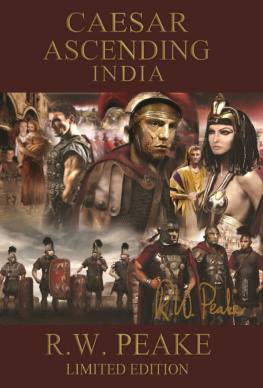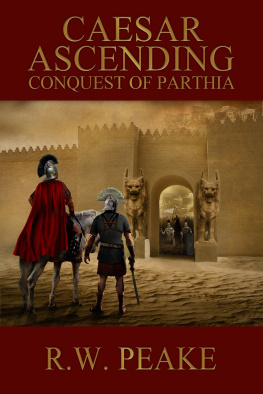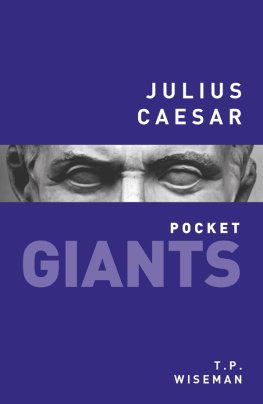R.W. Peake - Caesar Ascending-India Limited Edition
Here you can read online R.W. Peake - Caesar Ascending-India Limited Edition full text of the book (entire story) in english for free. Download pdf and epub, get meaning, cover and reviews about this ebook. genre: Detective and thriller. Description of the work, (preface) as well as reviews are available. Best literature library LitArk.com created for fans of good reading and offers a wide selection of genres:
Romance novel
Science fiction
Adventure
Detective
Science
History
Home and family
Prose
Art
Politics
Computer
Non-fiction
Religion
Business
Children
Humor
Choose a favorite category and find really read worthwhile books. Enjoy immersion in the world of imagination, feel the emotions of the characters or learn something new for yourself, make an fascinating discovery.
- Book:Caesar Ascending-India Limited Edition
- Author:
- Genre:
- Rating:4 / 5
- Favourites:Add to favourites
- Your mark:
- 80
- 1
- 2
- 3
- 4
- 5
Caesar Ascending-India Limited Edition: summary, description and annotation
We offer to read an annotation, description, summary or preface (depends on what the author of the book "Caesar Ascending-India Limited Edition" wrote himself). If you haven't found the necessary information about the book — write in the comments, we will try to find it.
Caesar Ascending-India Limited Edition — read online for free the complete book (whole text) full work
Below is the text of the book, divided by pages. System saving the place of the last page read, allows you to conveniently read the book "Caesar Ascending-India Limited Edition" online for free, without having to search again every time where you left off. Put a bookmark, and you can go to the page where you finished reading at any time.
Font size:
Interval:
Bookmark:
Limited Edition
Also by R.W Peake
Marching WithCaesar Birth of the 10 th
Marching With Caesar Conquest of Gaul
Marching With Caesar Civil War
Marching With Caesar Antony and Cleopatra, Parts I & II
Marching With Caesar Rise of Augustus
Marching With Caesar Last Campaign
Marching With Caesar Rebellion
Marching With Caesar ANew Era
Marching With Caesar PaxRomana
Marching With Caesar Fraternitas
Marching With Caesar Vengeance
Marching With Caesar Rise of Germanicus
Marching With Caesar Revolt of the Legions
Caesar Triumphant
Caesar Ascending Invasion of Parthia
Caesar Ascending Conquest of Parthia
Critical praise for the Marching with Caesarseries:
Marching With Caesar-Antony and Cleopatra:Part I-Antony
Peake has become a masterof depicting Roman military life and action, and in this latestnovel he proves adept at evoking the subtleties of his characters,often with an understated humour and surprising pathos. Very highlyrecommended.
Marching With Caesar-Civil War
"Fans of the author will bedelighted that Peakes writing has gone from strength tostrength in this, the second volume...Peake manages to portrayPullus and all his fellow soldiers with a marvelous feeling ofreality quite apart from the star historicalname... Theres history here, and character, and action enough forthree novels, and all of it can be enjoyed even if readers haventseen the first volume yet. Very highly recommended."
~The Historical Novel Society
The hinge of historypivoted on the career of Julius Caesar, as Romes Republic becamean Empire, but the muscle to swing that gateway came from soldierslike Titus Pullus. What an amazing story from a student now becomethe master of historical fiction at its best.
~Professor Frank Holt, University ofHouston
Caesar AscendingIndia, Limited Edition byR.W. Peake
Copyright 2018 by R.W. Peake
Smashwords Edition
All rights reserved. This book or anyportion thereof may not be reproduced or used in any mannerwhatsoever without the express written permission of the publisherexcept for the use of brief quotations in a book review.
Cover Artwork Copyright 2018 R. W.Peake
All Rights Reserved
With Caesar and his armys foray into India,I went along with them, after a fashion, both of us delving intoterritory about which we knew precious little. And, like Caesar, Iknow that Ive probably made blunders that readers with moreknowledge of ancient India might find inexcusable; if thats thecase, I offer my sincere apology and ask forgiveness. While ancientParthia certainly wasnt in my wheelhouse, so to speak, there wasenough commonality and source material with which I was familiarthat I didnt feel like I was drowning. Such was not the case withIndia, or at least, so I believed going into it, but although itsbeen several years ago now, I went through what I call one of myphases, where I immerse myself completely into an era of historyand absorb as much as I can before I move on to something else.And, fortunately, because of my interest in the campaigns of theMacedonian king Alexander, I had a fair amount of researchmaterial, at least to begin with. However, like Alexandersoriginal ambition, Caesars plan for India meant that I had toexpand my horizons, so to speak, and at least become more familiarwith the India of the First Century BCE.
I will say that one real surprise wasjust how extensive, and how far south Greek influence extendedalong the western coast of India, over and above what Alexander andhis conquering army brought with him, but it did help me, and byextension Caesar in crafting this story of what will be thebeginning of his invasion of India. Both Pattala (modern Thala) andBargosa (modern Bharuch) were Macedonian/Greek settlements,although the former was by conquest and the latter was an importanttrading center even before Alexander that was also conquered by aMacedonian. Aside from this information, however, I found itextremely difficult to locate any artwork or representations of thearchitectural style, so my assertion that both cities were laid outin the grid style popularized by Alexander and copied by Rome ispurely conjecture on my part. What proved even more difficult forme was trying to determine what were the dominant aspects ofsociety; specifically, administration, governance and religion, soagain, my depiction of a mixture of Greek and native Indian customsis also my attempt, however poor, to offer my best guess.Militarily was more of a straightforward matter, but again, itsbased in my supposition that, since Pattala was invested by Macedonto the point where Hephaestion built the citadel, and given how farnorth it was, their military was organized and trained in the morefamiliar style of the Pezhaitoroi , using the sarissa , while the forces of Bharuch commandedby Abhiraka are more of a blend of Eastern and Westerninfluences.
Concerning the King of Bharuch, Abhiraka, hewas a real man, of a group called the Western Satraps, who wereconsidered Indo-Scythians by Greek and Roman contemporary writers,but here was another place I took some liberties by moving him backabout a century, only because I was unable to pin down who camebefore him other than the name Higaraka. Therefore, Abhiraka is nowthe King of Bharuch (which I simplified from the more accurateBhragukutchh) and the commander of what will be the stiffestchallenge yet faced by Caesar, Titus Pullus, and their comrades inthe Roman army. My figure of two hundred elephants wasntcompletely arbitrary; in Strabos Geography there is mention ofkings who commanded an army with a thousand elephants, while itsknown that Porus fielded more than eighty against Alexander duringthe Battle of the Hydaspes. Given whats in store for the Romans, Idecided that a force of two hundred of these superweapons of theancient world would be a formidable challenge without beingunbeatable during the first encounter with them.
Keen-eyed readers will notice that oneof the things that I am consciously attempting to convey is thekind of challenges that I believe Caesar and the army wouldactually be confronted with as this campaign becomes more aboutCaesars ambitions than its original goal of subduing Parthia andrecovering Crassus standards. As readers of the first two booksknow, the challenges posed by the Parthians consisted oftheir cataphractoi , the useof naphtha (again, my conjecture), and finally, the difficultiesposed when facing former comrades in the form of the Crassoi .
With Caesars invasion of India, thereare new challenges, and the first of them is based on a truism ofmilitary professionals; amateurs study tactics, professionals studylogistics, and the first thing for me as the author was to look atwhat would have been a stunningly difficult logistical problem. Howwould the commander of a massive army in size and power transportand supply that army over a distance of thousands of miles? Theoverland route from Susa to Harmozeia alone is 710 miles, althoughthat includes the distance from Istakhr to the underwater city ofGur, then the overland route from Gur to Harmozeia. As much aspossible, I try to approach the stories I create with an eyetowards using everything I have learned about military science overthe previous 47 years, ever since I read Basil Liddell-Hartsstrategy as a very strange twelve-year-old, which is why Caesarforegoes any attempt to subdue Sogdiana, Bactria and thosetribesmen who proved to be such a thorn in the Macedonian kingsside, along with the incredibly challenging terrain. Also, sincethis is actually the beginning of the story that I completedwith Caesar Triumphant , Ifeel constrained by the idea of working within the framework of theworld in which Caesar lives ten years after the Ides, which is whenCT opens, particularly the events that I described in CT thatoccurred prior to that moment. Having said that, I have alsorealized that I need to make some minor tweaks to the end of thestory to better align with the beginning, but the one common threadthrough all of these stories is the recognition that its one thingto lead a force to a distant land, and another thing entirely tosupport it once its there. Consequently, I envisioned the creationof a series of logistical supply points, with the fictionalCaesarea, the historical Harmozeia and Barbarikon (Barbaricum), achain that will diminish in importance as Caesar and his army adaptto what is an increasingly foreign environment and learn to liveoff the land. Another challenge, and one with which I have had abit of experience, is how the Romans would cope with more tropicalconditions, particularly after spending two years operating in theclimate of modern-day Iraq and Iran, and the toll that it mighttake on men and equipment. Growing up in what, as much as I love myhometown of Houston, is pretty much a malarial swamp on the GulfCoast of Texas, Im familiar with things like mold, mildew, andhumidity thats so high you never really dry out, and I can onlyimagine what it was like for men whose clothing at that point wasmade of wool, who lived under leather tents, and what a sappingeffect that would have on morale and efficiency. Its just anotherproblem that Caesar is going to have to sort out if he hopes tokeep his army with him and continuing their march eastward, to theend of the world.
Font size:
Interval:
Bookmark:
Similar books «Caesar Ascending-India Limited Edition»
Look at similar books to Caesar Ascending-India Limited Edition. We have selected literature similar in name and meaning in the hope of providing readers with more options to find new, interesting, not yet read works.
Discussion, reviews of the book Caesar Ascending-India Limited Edition and just readers' own opinions. Leave your comments, write what you think about the work, its meaning or the main characters. Specify what exactly you liked and what you didn't like, and why you think so.










